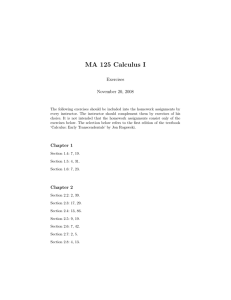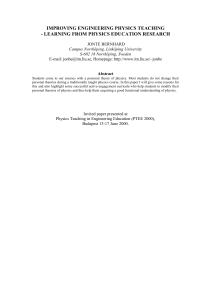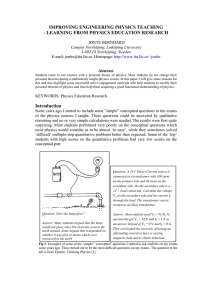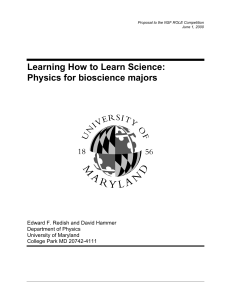Designing a PER-Based Introductory Physics Lab Nick Corak Honors Thesis Defense Presentation
advertisement
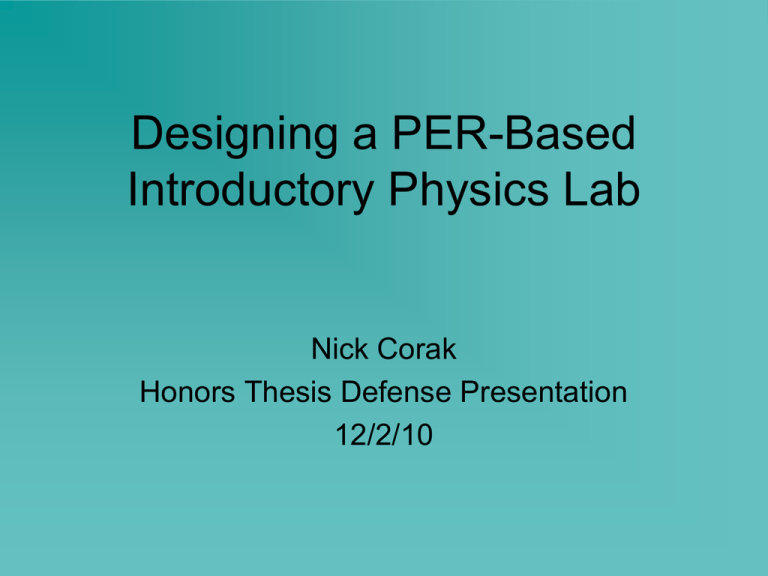
Designing a PER-Based Introductory Physics Lab Nick Corak Honors Thesis Defense Presentation 12/2/10 Acknowledgements • PER Groups – – – – UMd UC-Boulder UW UMinn • Honors Committee – – – – Dr. Black Dr. Davis Dr. Kubasko Dr. Morge Special thanks to Dr. Herman. Physics Education Research • Who are we teaching and why? • PER seeks to improve teaching methods based on: -observations -interviews -empirical data from surveys (e.g. MPEX and FCI) -pre and post test scores • Physicists working together to improve knowledge of how students come to an understanding of physics phenomena and how to effectively use that knowledge and understanding. • Our students need better training as more of them will be the future scientific leaders of the world. Model of Learning Cycle (Redish 2003) Research/Evaluation Curriculum Development Instruction Increasing Student Dialogue (Otero et. al. 2010) • Instructor poses thoughtful questions to students. • Students discuss with their group members as instructor walks around facilitating students’ questions. • Students ask each other questions which require student-student explanations. Student Dialogue (Redish 2003, Driscoll 1999) • Each student must have an opportunity to explain their thought processes whether it is in small group or plenary sessions. • During laboratory exercises, periodic questioning helps students to stay on track. • Ask what they are doing and why. • Arrange the lab so that there is time for discussion before, during, and after experimentation. Examples of probing questions: 1. What are you doing here? 2. What will that tell you? 3. What could go wrong? 4. Can you predict what will happen? 5. Is there another way? 6. Can you estimate what you will read on the next measurement? 7. Do you see any patterns? What is the rule for the pattern? Results from Learning Assistants (Otero et. al. 2010) • While working with learning assistants, students at the University of Colorado have an opportunity to explain their own difficulties and work through their misunderstandings. • These results show that students scores improved after recitation in a second semester introductory physics course. FIG. 4. Pre/postscores on the BEMA instrument for enrolled students compared to LAs. Histogram bars show data for students enrolled (N = 232) in a representative term of Calculus-based Physics 2 (Spring 2005). Am. J. Phys. 78, 1218 (2010) © 2010 American Association of Physics Teachers Epistemology (McCaskey 2009) • Defined as the origin of knowledge and its limitations. • Students and instructors need to be clear on expectation and goals of the course. • Students must be engaged in lecture, demonstrations, help sessions, and laboratory exercises. The must be engaged in their own learning process. • The focus of the lesson should be on what the students gain and how their physics knowledge grows. • Students must articulate what they think and how they reason through problem solving exercises. The lighter object reacts more. The lighter object feels more force. The lighter object accelerates more. TA: So, at the beginning of the tutorial, you guys had this intuition about, well, a lighter object is gonna react more in a collision. Right? And... and in a... you went through, did some calculations based on that, and it came out and it agreed with Newton's third law, right? But at the very beginning... uh... very beginning of the tutorial, you guys said it disagreed, right? So... how do you reconcile that? S1: I think we were thinking before, when we were talking at this checkpoint, that it really depended on what we were looking at [OK], cause in the beginning, we were talking about the acceleration of the car, and our calculations helped us figure out the force [OK], so it really depends on what you're looking at. TA: So, if I understand what you're saying, what you're saying is that your intuition was really telling you about acceleration, but then... you thought it was telling you about force? S1: Yes, in the beginning. And then, I guess [OK] the tutorial guided us through the... TA: OK, so... so now you... now you say it has to do with your acceleration, and so... does this mean that you can trust your intuition? S3: Sure. TA: Hm? (McCaskey 2009) S3: You just gotta know what it's talking about. Traditional Laboratory (Redish 2003) • • • • Goal: “Demonstrate the truths of something taught in lecture” or “produce good results.” Focus on content, not on what is important for student understanding of the items taught in lecture. Other goals: -Build mechanical skills -device experience -understanding error (research still needed for understanding student misconceptions with error). Narrowly focused dialogue. Observations from Traditional Laboratory Exercise (UNCW Fall 2009) • Students enter the class and work immediately on the procedure. • There was no introduction or background information. • Instructor did not make a connection of the spring lab what students are learning in lecture and what applications emerge from the lab. • The instructor read the lab procedure and analysis procedure. • The students paid little attention to the instructor. Some groups started the lab early. • The students did not gain physics knowledge from the pre-lab discussion. • Many students immediately had questions on the set up of the lab. • One to two students at each lab table worked on the lab while others watched and contributed little to performing the procedure and collecting data. Modified Laboratory Design (Heller 1999) A modified laboratory experiment should include the following basic outline: 1. 2. 3. 4. 5. Visualize the problem Qualitative physics description Plan a solution Execute the experiment Check and evaluate data 1. Visualize the Problem • This step allows students to answer the question “What is going on?” • Students construct a mental image of the situation • They sketch a picture of what they perceive to be going on. • Students determine exactly what the question is asking them to find. • Students discuss a qualitative approach. Note: This step occurs in groups of approximately 4 students. After small groups have an opportunity to discuss the situation, the groups share their ideas with other groups making comments and asking each other questions for clarification purposes. 2. Qualitative Physics Description • • • • Students draw diagrams with space and time relations. Students define relevant symbols and variables. Make predictions or estimations. State quantitative relationships from the general principles covered in class and any constraints or outside variables affecting the experiment. Note: This step and the following should be conducted in the small groups. After students plan a solution, the class discusses varying approaches, their strengths and weaknesses. 3. Plan a Solution • Choose a relationship containing the unknown quantity. Explain. • Do other variables affect the quantity? Adapt relationship if so. • What procedural steps are necessary? Explain. • Make sure units are correct. 4. Execute the Experiment • Did any modifications need to be made from the original solution plan? Make necessary changes. • Tabulate Data. • Make necessary graphs with correct labels. • Make calculations. • Simplify equation with units making sure they align. 5. Check and Evaluate Data • Express your answer. Does is answer the question completely? • Does your answer make sense? (Is it reasonable?) • Review the solution. • Share your group findings with the class. • What, if anything, could be done differently to answer the questions more completely? • Explain your results noting physical principles. Summary • Student discussions are an integral part for student learning. • Instructors can facilitate student discovery via a modified laboratory design. • We me move from traditional exercises towards student centered, inquiry based, laboratory design. References Driscoll, M. (1999). Fostering algebraic thinking: a guide for teacher grades 610. Portsmouth, NH: Education Development Center, Inc. Heller, P., K. (1999). Cooperative group problem solving in physics, University of Minnesota preprint. McCaskey, T. (2009). Comparing and contrasting different methods for probing student epistemology and epistemological development in introductory physics. Doctoral dissertation, University of Maryland. College Park, MD. Redish, E. (2003). Teaching physics with the physics suite. Hoboken, NJ: John Wiley & Sons, Inc. Otero, V., Pollock, S., Finkelstein, N. (2010). A physics department's role in preparing physics teachers: the colorado learning assistant model. American Journal of Physics, 78(11), 1220-1224.
